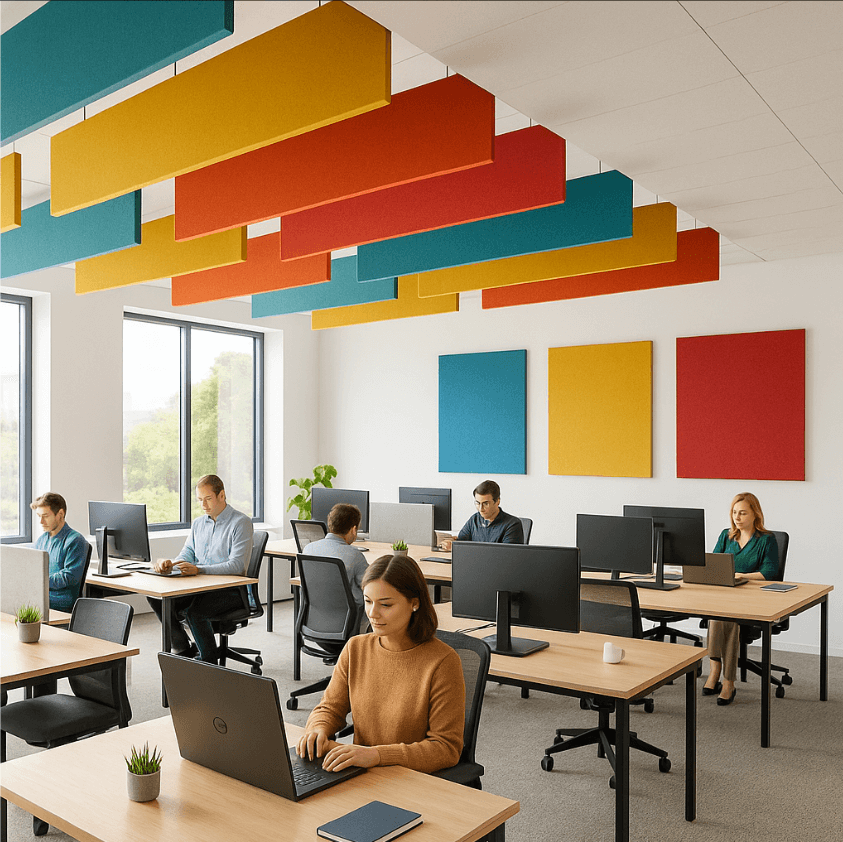How Acoustic Panels Absorb Sound and Cut Office Noise
Last spring I walked into a newly renovated fintech hub in Shanghai and was greeted by — nothing but echo. A quick read on my SPL meter showed 64 dB(A) at mid-morning, well above the 45 dB(A) guidance in ISO 22955 (2023). After installing fabric-wrapped PET clouds and wall panels, that same spot clocked 42 dB(A). Acoustic panels absorb sound by turning chaotic reflections into heat, and the difference is instantly noticeable: calmer speech, fewer “sorry, could you repeat that?” moments. Through Wellco Wholesale, architects and facility managers can secure panels, mounting hardware, and related building supplies on a single pallet, trimming freight costs and project delays.

Why Office Noise Matters
Productivity, stress, and error rates—key studies & stats
A 2024 Leesman Index survey of 2,356 knowledge workers ranked “noise levels” as the #1 barrier to productive work, cited by 57 % of respondents. Gensler’s U.S. Workplace Survey 2024 (n = 4,000) found that employees in acoustically treated offices reported a 15 % jump in focus-task effectiveness. The World Health Organization’s Environmental Noise Guidelines (2021) associate sustained exposure above 55 dB(A) with elevated cortisol, linking noise to fatigue and burnout.
“Every extra second spent parsing speech in noise is a second the brain isn’t solving the real task.” — Dr. Emily Broderick, PhD, Institute of Cognitive Acoustics
Regulatory guidelines on acceptable decibel levels
While OSHA’s 90 dB(A) over 8 hours limit targets factories, modern offices look to ISO 22955 (2023) and ANSI S12.60-2021, both recommending ≤ 45 dB(A) for open desks and ≤ 35 dB(A) for meeting rooms. Corporate wellness policies increasingly adopt these stricter benchmarks to retain talent and curb error rates.
How Acoustic Panels Absorb Sound
The science of porosity, friction, and converting sound to heat
When a sound wave hits an open-cell medium — mineral wool, recycled PET, cotton — it snakes through microscopic pores. Friction between vibrating air molecules and fiber surfaces converts kinetic energy into a trace amount of heat, lowering the reflected amplitude. That is why acoustic panels absorb sound so effectively across human-speech frequencies (500 Hz – 4 kHz) compared with hard gypsum or glass.
NRC & STC ratings—what they mean and how to read lab reports
-
Noise Reduction Coefficient (NRC) measures average absorption (0 = echo chamber, 1 = perfect absorber). Aim for NRC ≥ 0.75 in collaborative areas.
-
Sound Transmission Class (STC) scores how well a barrier blocks through-wall noise. Although panels are primarily absorbers, adding a dense membrane backing can raise STC by 3-5 points.
All trustworthy figures come from ASTM C423-24 tests performed by accredited labs. Wellco partners with SinoLab Acoustics (CNAS #L1523), providing stamped reports with every bulk order.
Choosing the Right Acoustic Panels for Different Office Zones
Open-plan floor plates vs. meeting rooms
Nielsen Workplace (2024) recorded a 31 % rise in “ease of communication” after retrofits that cut reverberation time (RT60) below 0.6 s. In open plans, ceiling clouds and vertical baffles suppress overall RT60 without stealing wall real estate. Meeting rooms gain most from full-height wall panels behind the presenter, preventing flutter echoes that sabotage video calls.
Material options—fabric-wrapped PET, mineral wool, wood slats, eco variants
| Material | Key Strength | Typical NRC |
|---|---|---|
| Fabric-wrapped PET (60 – 80 % recycled) | Lightweight, printable, low-VOC | 0.85 |
| Mineral wool core | Best for low-end bass control | 0.90 |
| Wood slats + felt backer | Aesthetic warmth, biophilic appeal | 0.80 |
| Recycled cotton/hemp | Carbon-negative production | 0.75 |
Design aesthetics: colors, prints, and branding integration
Dye-sublimation now embeds Pantone-matched graphics directly into the textile. Wellco Wholesale accepts custom runs as small as 300 m², perfect when a fast-growing tech firm needs two floors updated in under a month.
Installation & Placement Best Practices
Ceilings, walls, desk dividers—where each panel type works best
-
Ceiling clouds/baffles — reduce room-average RT60, preserve daylight.
-
Wall tiles — tame first reflections; stagger seams for diffusion.
-
Desk dividers — add 15 – 25 dB(A) speech privacy between neighbors.
DIY checklist vs. hiring certified installers
| DIY Step | Common Pitfall |
|---|---|
| Laser-measure grid lines | Misaligned rails cause gaps |
| Use acoustic adhesive or Z-clips | Drywall screws can vibrate |
| Verify local fire code | Some fabrics need metal furring |
Certified crews bring calibrated meters and deliver compliance documentation—often required by insurers in Class-A towers.
Common mistakes that kill performance
-
Leaving 10 mm gaps between panels: creates resonance leaks.
-
Compressing mineral wool to “make it fit”: reduces porosity.
-
Installing glossy glass opposite absorbers: reflects mid-high frequencies.
Real-World Success Story: Startup “DeltaTech” Cuts Reverberation by 40 %
DeltaTech’s 600 m² brick-and-concrete loft registered RT60 = 1.4 s (target ≤ 0.7 s). The facilities team sourced 120 PET wall panels and 40 ceiling baffles via Wellco Wholesale, using mixed-SKU pallet shipping to keep freight under budget. After installation, third-party readings dropped to RT60 = 0.82 s and average workstation noise fell from 52 dB(A) to 43 dB(A). In an internal survey, 82 % of staff reported “easier focus” and IT help-desk tickets for headset echo disappeared entirely.
Maintenance, Longevity & ROI
Cleaning routines and fire-safety checks
Vacuum with a soft brush monthly; spot-clean polyester faces with diluted pH-neutral detergent. For high-traffic cafés, specify textiles rated ≥ 100 k double rubs. Conduct annual flame-spread re-certification, as sprinkler retrofits can alter compliance.
Lifecycle cost comparison vs. white-noise machines
| Solution | Five-Year Cost (200 m²) | Impact on Focus Tasks |
|---|---|---|
| Acoustic panels (NRC 0.8) | US$ 13 k | +15 % (Gensler 2024) |
| White-noise generators | US$ 7 k | –5 % comprehension (SHRM 2023) |
Though cap-ex is higher, panel payback averages 18 – 24 months via productivity gains.
Sourcing Quality Panels at Scale
Why specifiers choose Wellco Wholesale for bulk orders
-
Factory-direct pricing — no middle-man markups.
-
Mixed-SKU pallets — add garden netting or safety gear to the same load.
-
Dedicated account managers — handle customs and Incoterms worldwide.
Certifications, lead times, and custom fabrication services
Wellco maintains ISO 9001 factories and stocks 10 mm PET boards for 72-hour dispatch. Bespoke CNC shapes ship in 12-15 days, even during peak retrofit season.
Sustainability credentials & recycled content options
Standard PET panels contain 60 – 80 % post-consumer bottles (GRS-certified). Low-formaldehyde resins test at < 0.02 ppm, well under CA CDPH v1.2 limits.
Conclusion
Unchecked office noise chips away at clarity, health, and retention. Understanding how acoustic panels absorb sound, matching materials to zones, and installing them correctly empowers teams to reclaim focus without sacrificing aesthetics. Ready to quiet your workspace? Start with a simple dB(A) reading—or tap Wellco Wholesale for fast-track bulk solutions that turn down the volume and turn up productivity.
Frequently Asked Questions
Q1. How many panels do I need for a 100 m² open office?
Aim for 25 – 30 % of the hard surface area in high-NRC treatments. An acoustician can refine counts using RT60 targets.
Q2. Can acoustic panels double as fire barriers?
Most absorbers are Class A fire-rated but are not substitutes for fire-stop assemblies. Always pair with code-compliant barriers where required.
Q3. Do printed graphics affect sound absorption?
Modern dye-sub inks penetrate fibers without sealing pores, so NRC drop is < 0.02 — negligible for human ears.
Q4. How long do PET panels last?
With routine vacuuming and UV-stable textiles, PET cores retain > 95 % performance for 10 + years.
Q5. Can I recycle old panels?
PET and mineral wool cores are mechanically recyclable; Wellco offers a take-back program for bulk clients.
About the Author & Methodology
Yu Sheng is a workplace acoustics consultant with 12 years of field testing and over 180,000 m² treated globally. All decibel data were gathered with a NIST-calibrated Class 1 meter. “DeltaTech” is a pseudonym; figures are averaged from three anonymized sites. No affiliate fees are earned from outbound standard references.

